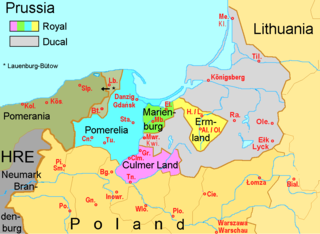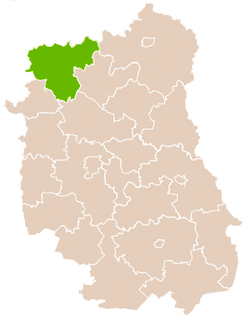 W
WChełm Land or Kholmshchyna is a historic region (ziemia) of eastern Poland and the adjacent areas of present-day Ukraine and Belarus. In the Polish–Lithuanian Commonwealth (1569–1795), Chełm Land was an exclave of the Ruthenian Voivodeship, completely separated from the main part of it by the Bełz Voivodeship. The region's most important town was Chełm. In the Commonwealth, Chełm Land enjoyed a special status, and even though it belonged to the Ruthenian Voivodeship, in some documents it was described as a separate, Chełm Voivodeship.
 W
WChełmno land is a historical region, located in central-northern Poland.
 W
WHalych Land was an administrative unit (ziemia) of the Kingdom of Poland, which existed from 1340 until 1772. Its capital was at the town of Halych, and local sejmiks at first took place at Sudova Vyshnia. In 1564 they were moved to Halych.
 W
WLauenburg and Bütow Land formed a historical region in eastern Pomerania. Composed of two districts centered on the towns of Lauenburg (Lębork) and Bütow (Bytów), it was on the western periphery of Pomerelia. The land is today part of the Polish Pomeranian Voivodeship.
 W
WŁuków County is a unit of territorial administration and local government (powiat) in Lublin Voivodeship, eastern Poland. It was established on January 1, 1999, as a result of the Polish local government reforms passed in 1998. Its administrative seat and largest town is Łuków, which lies 76 kilometres (47 mi) north of the regional capital Lublin. The only other town in the county is Stoczek Łukowski, lying 30 km (19 mi) west of Łuków.
 W
WLwów Land was an administrative unit (ziemia) of the Kingdom of Poland the Polish-Lithuanian Commonwealth. With capital in the city of Lwów, it existed between 1340 and 1772. Regional Sejmiks for Lwow Land, Sanok Land and Przemysl Land took place in Sadowa Wisznia. Legal system of the Land was based on the Magdeburg Law.
 W
WPrzemyśl Land was an administrative unit of Kyivan Rus, Kingdom of Poland and Polish–Lithuanian Commonwealth. It existed since the integration of Principality of Peremyshl into Kingdom of Ruthenia and until 1772, and was one of five lands of Poland's Ruthenian Voivodeship. Its capital was at Przemyśl, where local sejmiks also took place. Together with Red Ruthenia, Przemyśl Land was annexed by King Kazimierz Wielki in 1340. It remained part of Poland in unchanged form until 1772, when, following the first partition of Poland, it became of Habsburg's province of Galicia.
 W
WSanok Land was a historical administrative division unit (ziemia) of the Polish–Lithuanian Commonwealth from the 14th-18th centuries. It consisted of land that now belongs to the powiats (counties) of: Sanok, Brzozów, Lesko and partially Krosno and Rzeszów. Ziemia Sanocka was a part of the Ruthenian Voivodeship with the capital at Lwów.
 W
WZawkrze Zawkrze Land, is a small historic region of Poland (ziemia), located in northern Mazovia, along the border with Masuria. Its approximate area is 1,784 km2 (689 sq mi), and the population is about 114,000. Currently, Zawkrze has three towns, and more than 200 villages. Its name comes from the Wkra river – Zawkrze means the land behind the Wkra, from the perspective of Płock, historic capital of Mazovia. The largest town of the region is Mława, while historic capital of Zawkrze is Szreńsk.